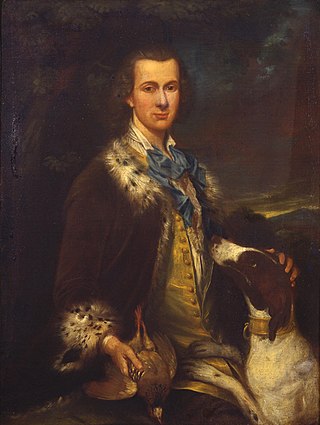
Viscount Cobham is a title in the Peerage of Great Britain that was created in 1718. Owing to its special remainder, the title has passed through several families. Since 1889, it has been held by members of the Lyttelton family.

Earl of Stair is a title in the Peerage of Scotland. It was created in 1703 for the lawyer and statesman John Dalrymple, 2nd Viscount of Stair.

Earl of Radnor, of the County of Radnor, is a title which has been created twice. It was first created in the Peerage of England in 1679 for John Robartes, 2nd Baron Robartes, a notable political figure of the reign of Charles II. The earldom was created for a second time in the Peerage of Great Britain in 1765 for William Bouverie, 2nd Viscount Folkestone.

Earl of Limerick is a title that has been created twice in the Peerage of Ireland, associated first with the Dongan family, then with the Pery family. It should not be confused with the title Viscount of the City of Limerick held by the Hamilton family also Earls of Clanbrassil.

Earl of Lonsdale is a title that has been created twice in British history, firstly in the Peerage of Great Britain in 1784, and then in the Peerage of the United Kingdom in 1807, both times for members of the Lowther family.

Christopher Wandesford was an English administrator and politician who sat in the House of Commons between 1621 and 1629. He was Lord Deputy of Ireland in the last months of his life.

Baron Masham is a title that has been created three times, once in the Peerage of Great Britain and twice in the Peerage of the United Kingdom. It was first created in the Peerage of Great Britain in 1712 when the courtier Samuel Masham was made Baron Masham, of Otes. In 1723 he also succeeded as fourth Baronet of High Lever. The barony became extinct on the death of the second Baron in 1776. The Masham baronetcy, of High Lever in the County of Essex, had been created by James I in the Baronetage of England on 20 December 1621 for Samuel Masham. The third Baronet was Member of Parliament for Essex. The baronetcy became extinct along with the barony in 1776.

Thomas Pelham, 1st Baron Pelham of Laughton Bt was a moderate English Whig politician and Member of Parliament for several constituencies. He is best remembered as the father of two British prime ministers who, between them, served for 18 years as first minister.
John Butler, 17th Earl of Ormonde, 10th Earl of Ossory (1740–1795) was an Irish peer and Member of Parliament (MP). He became a Protestant in 1764. He was an Irish MP, representing Gowran between 1776 and 1783, and Kilkenny City between 1783 and 1792. In 1791, his right to the peerage was acknowledged in the Irish House of Lords and he became the 17th Earl of Ormond.
Baron Ranelagh, of Ranelagh in the County of Wicklow, was a title in the Peerage of Ireland. It was created on 18 April 1715 for Sir Arthur Cole, 2nd Baronet, who had earlier represented Enniskillen and Roscommon in the Irish House of Commons. The Baronetcy, of Newland in the County of Dublin, was created in the Baronetage of Ireland in 1660 for his father Sir John Cole, 1st Baronet, a member of the Irish Parliament for County Fermanagh. He married Elizabeth Chichester, daughter of Lieutenant-Colonel John Chichester and the Honourable Mary Jones, daughter of Roger Jones, 1st Viscount Ranelagh, and aunt of Richard Jones, 1st Earl of Ranelagh. Lord Ranelagh was childless and the titles became extinct on his death in 1754.
There have been two baronetcies created for people with the surname Jenkinson, both in the Baronetage of England. The seventh holder of the first creation was elevated to the peerage as Earl of Liverpool in 1796, a title which became extinct in 1851.
There have been three baronetcies created for members of the Gore family, all in the Baronetage of Ireland. All three titles are extant. The family also holds two earldoms and a barony.

The Hales Baronetcy, is a title in the Baronetage of England. There were three Hales baronetcies. The oldest was created in 1611 for Edward Hales. He was a member of a Kent family. The second was created in 1660 for Robert Hales, MP for Hythe 1659, also of a Kent family. The third was created in 1660 for John Hales of Coventry, co. Warwick.
There have been two baronetcies created for people named Cole, one in the Baronetage of England and one in the Baronetage of Ireland.

Christopher Wandesford, 2nd Viscount Castlecomer was an Irish politician who sat in the Parliament of Ireland in 1707 and in the British House of Commons between 1710 and 1719.
Sir Christopher Wandesford (1592–1640) was MP for Aldborough, Richmond and Thirsk and Lord Deputy of Ireland, 1640.
Christopher Wandesford, 1st Viscount Castlecomer was an Anglo-Irish politician and peer.
John Wandesford, 1st Earl Wandesford was an Anglo-Irish peer.

Earl of Arran is a title in the Peerage of Ireland. It is not to be confused with the title Earl of Arran in the Peerage of Scotland. The two titles refer to different places: the Aran Islands in Ireland, and the Isle of Arran in Scotland. The Irish earldom is held by the Gore family. The Scottish earldom is a separate title, held as a subsidiary title of the Duke of Hamilton.









